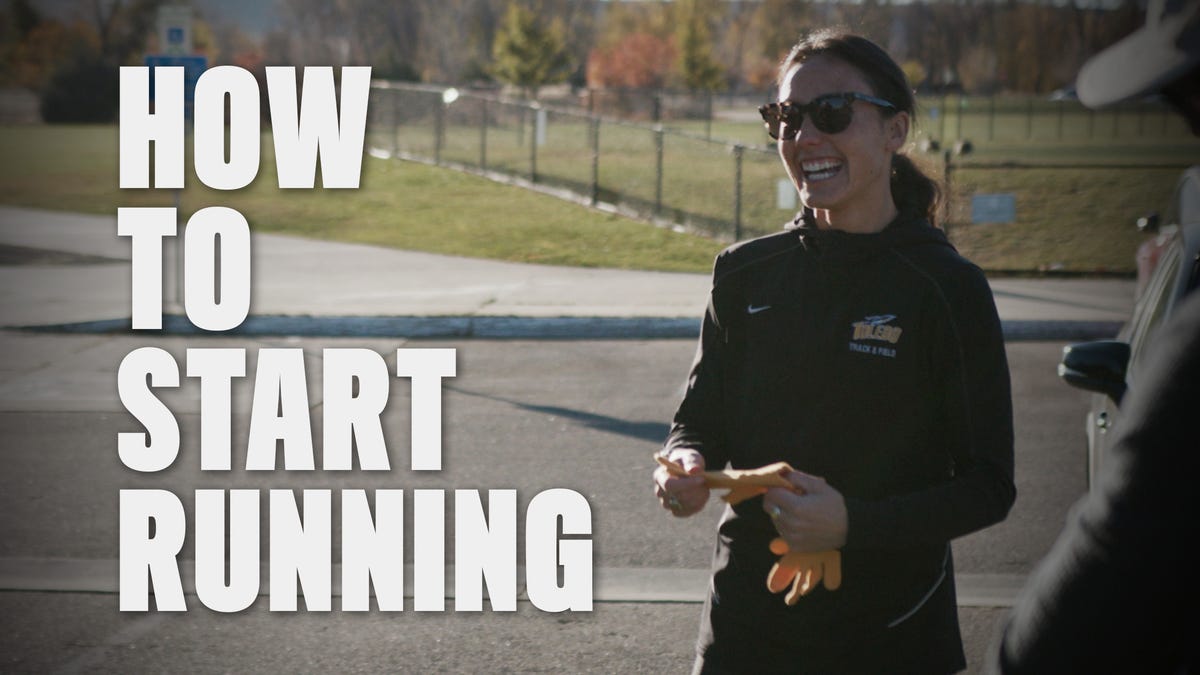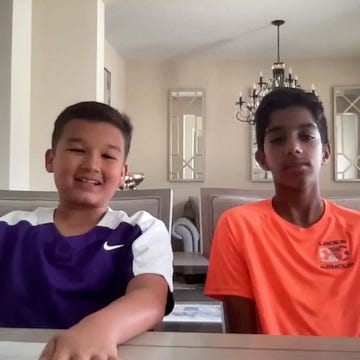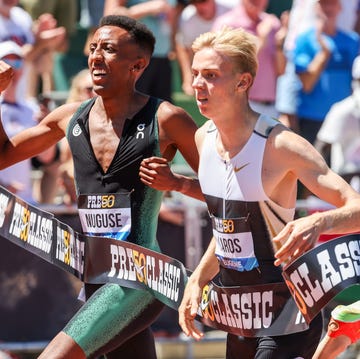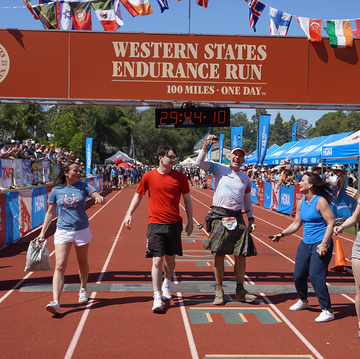On August 25, Mike Smith, the director of cross country and track and field at Northern Arizona University, gathered his athletes in Flagstaff and told them his news: The 2024–25 academic year will be his final year coaching the team. He plans to remain in Flagstaff and coach a group of professional athletes after the NCAA outdoor track championships in June 2025. Smith’s longtime assistant, Jarred Cornfield, will take over as NAU’s head coach at that point.
Runner’s World learned that the pro group will be sponsored by Nike. But Smith’s current pros, who represent different brands, including Nike, Adidas, Lululemon, and Hoka, will be grandfathered in with Smith and allowed to retain him as their coach.
In an interview with Runner’s World on August 30, Smith, who remains under contract with NAU, an Adidas-sponsored athletic department, for the next nine months, discussed how he knew it was time to shift to coaching only pros, the changing landscape of college athletics, and how his five professional athletes who raced at the Olympics in Paris performed. He asked not to answer questions about his new pro group, because he doesn’t yet know what form it will take.
This conversation has been lightly edited for clarity.
Runner’s World: How did you know it was time to make this change? It seems like these opportunities come your way from time to time—all the big-name college coaches get these offers. Why now?
Mike Smith: It really was a combination of a few things. As a family, we had reached a point where we were going to have to make some decisions about the direction of my career. In my time at NAU, our program has changed a lot and grown, in particular the women’s program.
I went from being a college coach to being a college coach and pro coach, and I think Budapest in 2023, that was a moment of big reflection for me. I’ve got four athletes in the World Championships. It’s also the NAU preseason cross country week, which is a very formative week of our season.
And I’ve got a four-month-old baby and her mom at home, and I felt so over committed. I felt like I was letting down my professional athletes, my college athletes, and my family. And I think that was maybe the start of looking at like, “All right, I really want to zero in my focus.”
At the same time, I want to be someone that challenges themselves. And I asked myself, “What would I tell my athletes?” I’m constantly have meetings in my office, encouraging people to step toward the harder thing. And I think I could have stayed in college coaching a long time, and that’s for sure the easiest option for me. We’ve [had] a lot of success. I feel really comfortable in my position, and this is a whole new challenge for me, so trying to kind of take my own medicine as a coach of stepping toward what’s harder.
So just to be clear, you missed Budapest? You stayed home?
Correct. I stayed home, not an easy decision. I told my pros I was a college coach first and when they signed up, they signed up for for that relationship. That doesn’t mean that’s always an easy pill to swallow, and the World Championships certainly were not an ideal circumstance. If you look ahead to the global calendar, you know Tokyo [World Championships in 2025] is going to be in September. It wasn’t going to get any easier.
What do you find that pros need from a coach versus what college students need from a coach?
What both share is [needing] an element of reassurance and stability and calm in these really heightened moments. And then I think those kind of manifest differently. It’s very much a group setting with college and with their age and experience, there’s probably a lot more on us, of like leading the way for how to conduct ourselves in a team format and at really big moments like the NCAA championships.
For professionals, there’s probably more of a logistical component of it with agents, traveling just to go to the Olympics, you’re going to get someone through, their luggage, the Village, the warm-up track, the language, the time zone, and there’s all those pieces that are energy bleeds. If you can make that easier, I think that is very much [part of] being a pro coach. But bottom line, at the end of the day, in what feels like the biggest moment of life, walking into the Olympic stadium, and you just want those people with you, beside you. I think I’d be the same way if I was an athlete.
How did your college kids take the news? You’re giving them a lot of notice compared to what athletes typically encounter when it comes to coaching turnover. Do they realize that?
I give them so much credit. I don’t know what I was expecting. I was just dreading that conversation, because I feel like I made huge commitments. They chose our school versus going to anywhere else in America.
What I was met with was incredible understanding. You know, there’s a lot of tears, saying they support me. But that doesn’t mean it’s easy, and especially for younger athletes who haven’t been here for a long time. I think naming Coach Cornfield as the next head coach provides a lot of stability. That could have been a lot harder conversation if he wasn’t going to step right in.
At NAU, for those kids, it’s all about the team. It’s doing what they do for the good of the team. Pros have teams, but they’re not really teams. They’re training groups, right? And is that necessary for pros these days? Is that the ideal training environment? I’m thinking of Grant Fisher, who stepped away from a renowned training group and is actually doing better. What is the highest ideal of pro training in this country? And has that changed at all?
That is a question I’m super interested in. I think if you follow the trends over the decades, there are collections of training partners. If you saw Boulder in the ’90s or Boston in the ’80s or Gainesville, Florida, you saw collections of training partners that weren’t necessarily teams. And you hear people talk about that. It was a way to take all the good without any cumbersome obligation or structure. So when I’ve coached pros, I’ve tried to really keep it to that, to a collection of training partners who can help each other. The big reason people group up together is the training partner aspect of what we do.
And then I look at the way we conduct the program for college athletes. Everything is team. It’s way beyond a collection of training partners. It’s how we recruit, how we motivate, literally down to our race plans. Everything is about the group and the team.
Living in Flagstaff so long, I see a lot of challenges with collections of training partners that then try to conduct themselves, like, say, an NBA team. So I’m really interested in that.
I’m really interested [as] someone that’s coming from having a lot of success, and my brain just naturally thinking from a group perspective, that the team is the highest good. I don’t know if that is—when that becomes really forced and not very natural for collections of professional athletes, there’s potentially some things you can lose there. So I’m really interested in that, and I want to take the next nine months to be a good listener and ask lots of questions and really study that element of group training.
Do you think brands are more open to these mixed groups these days? You’ve got Team Boss with a bunch of people from different brands. You’ve got Ed Eyestone coaching Nike and also Asics and Clayton Young, Diljeet Taylor coaches pros who represent different brands. Do you think that’s the way the world is shifting? The performance is what matters, not the brand on your jersey? Or is it too early to say?
I think it’s too early to say. There are different conversations, right? There’s a marketing executive that probably dreads it. And then there’s someone that sees it as like, “Hey, look, if that’s going to make everybody better, it’s worth it.” It probably depends who you’re asking here. It’s probably not anyone’s preference, but if it’s raising the bar all around, I think it’s an interesting conversation.
The college sports landscape is changing dramatically, and there’s huge concern about what will happen to Olympic sports now that colleges can basically directly pay their football and basketball players. Did that play into your decision at all? How do you see that playing out?
That was not a motivating factor of my decision, and I feel like NAU being such a desirable program, and Flagstaff being such a desirable location, we’re always going to recruit at a very high level. I also know how we run our program. This is always going to be, no matter what, a top destination for people to come to develop. I really believe that.
I will say the change in the last few years, what college athletics is and the types of conversations we have, is not my preference. It’s not what I got into it for. It’s an ever-evolving landscape. And in my best moments, I would tell myself, like, “Okay, let’s challenge myself in this new era to hold true to the values that I believe in. Maybe there’s even better opportunity to get people to choose things for the right reasons versus just money.” But you’re going to see a lot of wild changes as time goes on. It’s really an interesting time.
Can you elaborate on that? Do you have recruits saying to you, “What can you do for me in terms of NIL?” Is that the conversations that you’re talking about?
I would say finances used to come up way later than they do now. That’s the first thing, right? We will have people who want to get right to it, talk about dollars a couple minutes into meeting them. They’re used to that from other coaching conversations. We built our program at NAU by relationships in the recruiting process. We would build these relationships way far out. By the time someone came to visit, we had really put high value in those relationships.
And people get on the [transfer] portal now, and they’re going to make a decision in a day. And a lot of it is around cost. So that’s one of biggest changes, like, whoa whoa whoa. I want to feel like the recruiting relationship is front and center of what we’re doing, and the other stuff is secondary.
But I don’t know everyone’s financial situation. I try not to have any judgment on that. People’s family situations are really different. A couple thousand bucks to a seventeen-year-old. It’s a really big deal, right?
Can we do a quick breakdown of your Olympians and how it went in Paris?
I had five athletes, and there’s a certainly a real mixed bag of what happened there. If you want to start with Nico [Young, who finished 12th in the 10,000 meters in 26:58.11], I thought that it was such a defining performance of who I know Nico to be. He had been going for 13 months straight. So much of success could have been defined by, oh, you made the team, now just go and enjoy the experience. And he would not. He refused to let himself off the hook with representing himself as a racer and then representing his country. And he raced that as hard as any race you’ve ever seen.
When I finally got to see him on the practice track after, I said, “That is one of my favorite races you have ever run, because I know that everyone would have understood if you just were happy to be here. And instead, you raced it with such honor and courage. And that’s who you are.” And I think that really set the tone for future championships of Nico Young. He’s going to give it everything he’s got.
I know that’s always who he’s been. But you know, if you didn’t do that after such a long year, long season, who could ever blame him? It’s also the guy that I’ve always known. Man, I remember his freshman year at NCAAs. It’s pretty normal for freshmen to be nervous or scared or just happy to be there and he wouldn’t take any of that as a freshman. Just fearless. (Young finished fourth in the 10K at the NCAA cross-country championships, held in March 2021 due to the pandemic.)
Woody Kincaid finished 16th in the Olympic 10,000 meters in 27:29.40.
Just really proud of Woody. We all want perfect run-ups to these situations. And the question is, when it’s not a perfect run-up, who responds? I think that’s a big statement about Woody Kincaid is like, we saw a historic 10K finals, how fast that was. Woody wasn’t in 26:40 shape on that day, he did his best in that situation, [given] some interruptions he found himself with leading into Trials, the Games, and not our preference. But I was very proud of him.
Abdihamid Nur had this freak injury injury in the second heat of the 5,000 meters. How far into the race was that?
It was 100 meters to go. He tore his post [tibial tendon], when his left foot got tangled with someone else. I’ve never seen an injury like that in my time as a coach. I’ve seen rolled ankles and irritation in that tendon, but I’ve never seen someone snap that in half.
I think we all have to remember in this business that you’re trying to mitigate risk and make it so what happens is planned. But there’s still an element of total luck in this, and really hard things happen. It isn’t about who deserves it. But yeah, we can probably come up with a lot of examples of really hard things that occur, where you did everything right, and it’s just the hand you got dealt. So it’s a chance to show himself and everyone else who he is and how he responds, and that’s what we’re going to focus on.
How long a recovery is he looking at?
Hard to say. He [had] surgery immediately and the best surgeons possible. And he’s already got way more mobility. He started on his rehab protocol. So we’re already down that road. I was with him in Colorado for surgery, the main thing was just not waiting, getting on that immediately.
What about Luis Grijalva? He was in the same heat as Abdi.
He stayed on the feet. He made contact with the cameraman, if you can remember that incident, when a cameraman wandered out on the track.
The truth is, Luis was in pretty rare, exceptional fitness that was timed just right. And at our pre-Olympic altitude camp in Font Romeu, he got a high hamstring strain that we that we didn’t think was anything. And it just did not go away. It really limited the extension of his stride.
And he’s another example of what we signed up for, operating within really fine margins. And I think in all the stories you hear of the heartbreak of the Trials or the Olympics, of people flying too close to the sun, you see that’s the world we’re all part of. You know, it’s like, you try to time it just right. And I really own that as a coach. He didn’t need to do one last workout. I wish we just didn’t do that, and I think he would have had a really good chance of medaling. And I’ll carry that with me for a long, long time. I first put the blame on myself, and you know, we did everything just right. But, man, you’re always walking a really fine line. And up until, shoot, the week before, I thought this is all going to clear up, and it just never went away.
Can you talk about the 1500 with Nikki Hiltz? They’ve become an icon and their performance was about so much more than running. But also, the race went out in 59 seconds for the first 400. What were you thinking at that point?
I thought Nikki’s Olympic Games was just such a success and accumulation of a lot of their growth as an athlete. The big thing is that Nikki’s always been someone that runs fast, super talented. But I think the missing piece, they would have told you, was they wanted to be consistent at a championship level.
And so we saw it with the U.S. Trials for Budapest. But then when they went to Budapest, they did not advance to the final, and that really stung. And so I think when you look at the execution at the Olympic Trials of who they were up against, that’s the deepest women’s field ever at the Trials, that is just an unbelievable field, and it really says where the 1500 is in the U.S. To manage the mind through that and know that this outcome would be such a defining moment, and to not panic or freeze, I thought that just said so much about their growth.
To make it through those rounds at the Olympic Games to make it to that Olympic final, we’d already won. Just standing there on that line. And then to your point of how that race was run.
You know, thankfully we knew how the Trials would be run. There was no surprise that the Trials final was going to be a 3:55 race. And in fact, at the 2023 Trials, when Nikki outkicked Athing Mu and Sinclaire [Johnson], in that moment, I said, “They are not going to let you in that position a year from now at the Olympic Trials.”
So we had a year of getting the mind ready for that. Nikki ran the two mile at Millrose (in 9:15.80), when they easily could have run the mile. We did hefty, hefty threshold work at altitude, getting them ready, but a big thing was preparing the mind for years to make that thing run at the Trials. And if you’re ready for that, then you’re going to be ready for the Olympic final, because they’re going to blast.
And 59, that’s too fast. There’s the physical element of what the pace does, but then the psychological. And I think you saw the men’s 1500 running that fast, it’s like, for all of them, it’s so courageous to believe and not be scared and to go out that fast in the moment that matters. So to me, it was just so cool that Nikki and Elle [St. Pierre] and Jess Hull, they were not, they were not going to back down to that moment. They believed they were there, and they responded in an historic race.
A reporter did ask Nikki afterward, “Well, why not hang out at 2:04 pace and then see what happens?” And they were like, “No, that’s not the way it works.”
Nikki Hiltz got praised their whole career, sitting back with this big kick, right? So you’ve got to understand how scary that is to, you know, race in a way that is contrary to what you’ve been told since you’re a kid. “Oh, you’ve got this big kick, but you gotta save it.” And so the way they’re racing, to me, is conquering the dragon. Of course, they could have hung out at the back. Instead they went for it and that to me is like, 40 years from now, you’ll be so proud of that. No question.
If you had an advanced preview of the splits of that race, and then you could rewind in time and tell Nikki on the starting line, would you have said anything different? Would you have said, “Don’t go out harder than 62?”
I think you saw Nikki was gauging carefully. Like, when Faith Kipyegon moved up and Nikki let her in. Nikki’s really good at sensing it. They knew how quick it was. And no, I wouldn’t have done anything different, to be honest with you. It’s so easy to say, “Oh, you know, you let them go a little bit and then come on strong.” But you understand that contact and connection is a huge piece of this. And if [the field] gaps you a little bit there, you can’t just run a 57 to catch back up. The connection and contact, you saw it in the men’s 1500. They had to choose between the connection or the pace. And they chose connection. And I think that’s the decision these athletes have to make when it goes that.
I spoke briefly to Ricky Simms, Galen Rupp’s agent, at the Trials, and he said Galen had surgery after the Marathon Trials. How is he doing?
He had surgery on a hip that had been giving him trouble for years right after the marathon Trials, and that was a really long, slow rebuild. And fortunately, he’s getting healthy, but there was a long, long road, and he is still on it. So we’ll see. I mean he’s a competitor. If he can come back, he will. He had a pretty significant surgery.

Sarah Lorge Butler is a writer and editor living in Eugene, Oregon, and her stories about the sport, its trends, and fascinating individuals have appeared in Runner’s World since 2005. She is the author of two popular fitness books, Run Your Butt Off! and Walk Your Butt Off!
















